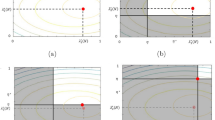Abstract
Numerous laboratory experiments have investigated the performance of several processes for providing public goods through voluntary contributions. This research has been able to identify features of the institution or environment which are reliably likely to produce outcomes “close” to the free riding outcome or “substantially” greater than the pessimistic prediction of standard models. One such feature is the “marginal per-capita return” (MPCR) from the public good. Various authors have altered MPCR between groups or for an entire group at the same time. The experiments reported here address a different question, “What would happen if, within a group, some persons faced a ‘high’ MPCR while others faced a ‘low’ MPCR?”
Similar content being viewed by others
References
Andreoni, J. (1988). Why free ride? Strategies and learning in public goods experiments.Journal of Public Economics 37: 291–304.
Andreoni, J. (1993). An experimental test of the public goods crowding-out hypothesis. Mimeo. University of Wisconsin.
Bagnoli, M. and McKee, M. (1991). Can the private provision of public goods be efficient? Some experimental evidence.Economic Inquiry (April): 351–356.
Brookshire, D.S., Coursey, D.L. and Redington, D.B. (1988). Special interests and the voluntary provision of public goods. Mimeo. November.
Fisher, J. and Schatzberg, J. (1988). Asymmetric payoffs in prisoner's dilemma games. Mimeo.
Isaac, R.M., McCue, K. and Plott, C.R. (1985). Public goods provision in an experimental environment.Journal of Public Economics 26: 51–74.
Isaac, R.M. and Walker, J.M. (1988a). Group size effects of public goods provision: The voluntary contributions mechanism.Quarterly Journal of Economics 103: 179–201.
Isaac, R.M. and Walker, J.M. (1988b). Communication and free riding behavior: The voluntary contributions mechanism.Economic Inquiry 26: 585–608.
Isaac, R.M. and Walker, J.M. (1993). Nash as an organizing principle .... Mimeo.
Isaac, R.M., Walker, J.M. and Thomas, S. (1984) Divergent evidence on free riding: An experimental examination of some possible explanations.Public Choice 43: 113–149.
Isaac, R.M., Walker, J.M. and Williams, A.W. (1994). Group size and the voluntary provision of public goods: Experimental evidence utilizing very large groups. Forthcoming,Journal of Public Economics.
Kim, O. and Walker, M. (1984). The free rider problem: Experimental evidence.Public Choice 43: 3–24.
Ledyard, J.O. (1993). Public goods: A survey of experimental research. Mimeo. California Institute of Technology, August. Forthcoming in A. Roth and J. Kagel (Eds.),The handbook of experimental economics.
Marwell, G. and Ames, R. (1980). Experiments on the provision of public goods. II. Resources, interest, group size, and the free rider problem.American Journal of Sociology 85: 926–937.
Olson, M. (1971).The logic of collective action. Cambridge, MA: Harvard University Press.
Palfrey, T.R. and Prisbrey, J.E. (1992). Anomalous behavior in linear public goods experiments: How much and why? Mimeo. California Institute of Technology. September.
Author information
Authors and Affiliations
Additional information
The heterogenous group experiments reported here were conducted at the Economic Science Laboratory of the University of Arizona. All data are archived on the NovaNet computer system and are available from the authors upon request. The financial support of the National Science Foundation, grants SES-8820897 and SES-8821067, is gratefully acknowledged. Fisher and Walker are at Indiana University; Isaac and Schatzberg are at the University of Arizona.
Rights and permissions
About this article
Cite this article
Fisher, J., Isaac, R.M., Schatzberg, J.W. et al. Heterogenous demand for public goods: Behavior in the voluntary contributions mechanism. Public Choice 85, 249–266 (1995). https://doi.org/10.1007/BF01048198
Accepted:
Issue Date:
DOI: https://doi.org/10.1007/BF01048198




